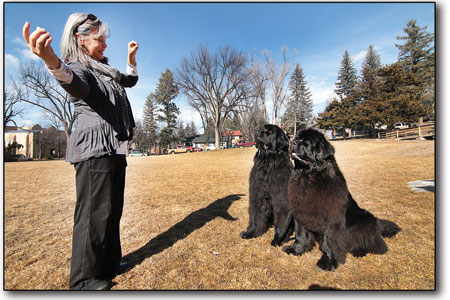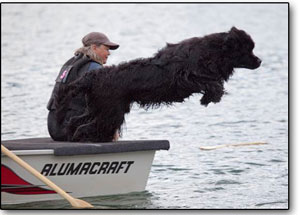
Lynn Kitch gives a command to her Newfoundland family, T-Bone and SeeSea. The two dogs have passed the American Kennel Club’s Canine Good Citizen test, have AKC Companion Dog obedience titles, and are AKC champions. SeeSea is even an AKC “Grand Champion” and Canadian Champion./ Photo by Jennaye Derge
Running with the big dogs
Local couple enjoys life with Newfoundlands
by Jen Reeder
It’s probably not surprising that Cory and Lynn Kitch, co-owners of Home Slice Pizza, have dogs that love pizza. The two Newfoundlands even have a favorite topping: pepperoni.
“They actually know the word ‘pizza,’” Lynn says, looking at the 135-pound dog panting near her. “Hey SeeSea, you want some pizza?”
At the mention of pizza, SeeSea’s head whips toward Lynn and she looks up hopefully. Lynn laughs and strokes the dog’s head.
But knowing the word “pizza” is the least of the accomplishments of the two dogs. Both T-Bone, a 170-pound male, and SeeSea, his 135-pound “little” half-sister, have passed the American Kennel Club (AKC)’s Canine Good Citizen test, have AKC Companion Dog obedience titles, and are AKC champions. SeeSea is even an AKC “Grand Champion” and Canadian Champion.
SeeSea competes around the country in conformation shows (dog shows in which dogs are judged by how closely they conform to a breed’s standards – think “Best in Show”) and based on her wins, was one of the top 20 Newfoundlands in 2014. After she won “Best in Show” at the AKC dog show last September in Grand Junction, the Kitches celebrated with champagne – but not before rewarding SeeSea with a trip through a Dairy Queen drive-thru for vanilla ice cream.
“It’s something else to be proud of your dogs for. We’re proud of them, we love them. We think they should win everything,” Cory says with a laugh.
T-Bone competes in skills competitions like obedience, as well as Newfoundland Club of America working dog titles in water rescue and drafting. Today, the primary job of working “Newfs” is to save people who are drowning; the Italian Coast Guard has K-9 lifeguards that leap from helicopters to save people. In water rescue tests for the Newfoundland Club of America, Newfs jump out of boats for missions. T-Bone is a natural – he sprang out of a boat on his very first day of water rescue training, and the first time he swam, it was to “rescue” a family friend named Jordan from Vallecito Lake.
“T-Bone was pacing by the shore – it totally clicked with him. He thought because Jordan was out there in the water and talking that he was in trouble,” Lynn says.
T-Bone swam to Jordan, who grabbed onto the fur on T-Bone’s rump, as Lynn instructed.
“I was crying when he pulled him in. I was just so happy that he swam. Cory said, ‘Not only did he swim, he saved somebody.’”
Newfoundlands were originally bred to help people not just with water activities (hence their webbed feet) but to pull carts full of timber. In drafting tests, T-Bone will be hitched to a 25-pound cart that he pulls along a 1-mile course, among other challenges. Lynn says all the dog owners cheer for one another’s dogs during the tests.
“The goal is to bond with your dog and your friends – you have all these people with common interests,” Lynn says. “I have met people from all over the country now that I’m friends with … we just love this breed and want to maintain the integrity of the breed and move forward in a really positive way.”
In fact, Lynn is an ambassador for the Newfoundland Club of America. Through the club’s website (www.ncanewfs.org), people can contact her with any questions they might have about the breed. Prospective owners often wonder what it will be like to share a home with a dog as big as a Newf, so she’s invited many people to her house to see what the dogs are like inside (Cory’s take: “Like a rug on valium.”)
The American Kennel Club’s standards declare “Sweetness of temperament is the hallmark of the Newfoundland; this is the most important single characteristic of the breed.” True to form, Lynn says Newfoundlands love their people and always want to be with them, and are good with children.
For instance, she says T-Bone and their 4-year-old niece Avi are inseparable. Once, when they were both heading for the back door, the little girl fell and without missing a beat, T-Bone leapt over her and then turned around to see if she was OK. Another time, Avi wandered through the accidentally open front door toward the street. T-Bone ran to alert Cory and Lynn and led them outside, where they found T-Bone blocking Avi’s access to the street and gently herding her back toward the house.
“They’re super great with children,” Lynn says. “They love kids, they love families.”
Still, bringing home a Newfoundland is not a decision to be taken lightly. They require a fair bit of grooming and can eat a fair bit of food, particularly in their first few years of growth (when T-Bone was 9 weeks old, he already weighed 20 pounds). Like all dogs, they need exercise, so Lynn’s Newfs run alongside her when she rides her bike. And there’s another thing.
 T-Bone, along with Lynn, trains for his water rescue test on Lake Vallecito last summer. “Newfies,” as afficionados call them, are known as strong swimmers and often used to save drowning victims./Courtesy Photo |
“It’s not a breed recommended for people who don’t like slobber or shedding,” Lynn says.
She says it’s crucial to find a reputable breeder interested in the health and welfare of their dogs, rather than one motivated by profit.
“If you’re going to get a specific breed because you like it for whatever reason, then be responsible. Go to that breed’s national website, do your research, and find a responsible breeder – not a backyard breeder that’s breeding to turn a dime.”
For instance, T-Bone and SeeSea came from Mountain High Newfoundlands in Rifle, which only produces one litter of pups each year. In contrast, “puppy mill” breeders keep a large number of dogs living in substandard conditions. (Dogs from puppy mills are often sold at pet stores; the Newfoundland Club of America prohibits its members from selling to pet shops.)
Though it can be considered controversial in Durango to purchase a purebred dog instead of adopting one from a shelter, Lynn says responsible breeders and owners have an important role in preserving the heritage of purebred dogs. In some cases, they even help preserve the existence of a breed; once-popular breeds like the Skye Terrier and Otterhound are now threatened with extinction.
For Lynn’s part, she loves all of the different activities and experiences she and Cory can share with their Newfoundlands.
“I think there’s a voice out there for everybody that owns any different kind of dog, whether it’s a purebred dog or a mixed-breed dog, but we have a choice,” she says. “My Newfoundland was bred to swim in the water, pull nets and haul carts, and I do all that with him … I just love this work with them. It’s like poetry in motion. It’s a beautiful thing.”
For more information about Newfoundlands or to contact NCA Ambassador Lynn Kitch, visit www.ncanewfs.org. If you are interested in applying to foster or adopt a Newfoundland from the NCA’s Newfoundland Rescue Network, visit http://www.ncarescue.org/.
